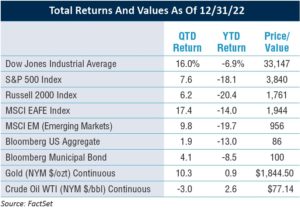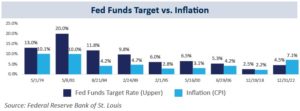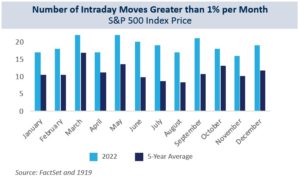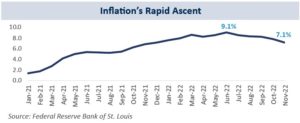Investment Review & Outlook – January 2023
 Key Takeaways
Key Takeaways
- 2022 was defined by inflation that proved not to be transitory and which was further exacerbated by the war in Ukraine. The Federal Reserve responded with sharp rate increases which led to double-digit declines for both stocks and bonds.
- A moderate recession likely is on the horizon in 2023, with higher unemployment and lower corporate earnings, as a result of the Fed’s aggressive monetary policy stance.
- Volatility continues to roil the equity markets while fixed income has become a more-attractive alternative for investor capital due to rate increases.
The Economy
Persistent inflation that exceeded expectations was the 2022 economic headline in the US and throughout the world. Ongoing pandemic-related supply constraints, labor shortages, government policies, and a rebound in consumer spending were further exacerbated by the Russian invasion of Ukraine and China’s zero-Covid policy closures.
…THE FED ORCHESTRATED THE MOST SIGNIFICANT MOVEMENT IN INTEREST RATES SINCE THE 1980S, RAISING INTEREST RATES 7 TIMES IN 9 MONTHS…
The Fed appears to have underestimated the stickiness of those forces keeping inflation at a high level. As a result, the Fed orchestrated the most significant movement in interest rates since the 1980s, raising interest rates 7 times in 9 months. This aggressive monetary policy followed quickly on the heels of the unprecedented levels of financial stimulus the Fed had provided to buffer pandemic challenges for consumers and businesses.
These same dynamics remain in place as we start 2023, as inflation, Fed rate hikes, and recession concerns dominate the headlines and investor attention. Until there is clarity that the economy has slowed enough to bring inflation down, taking pressure off the Fed, but not so much that a severe recession materializes, the dramatic swings in markets that we experienced in 2022 will continue.
Why A Moderate Recession?
The likely outcome of the Fed’s commitment to quelling inflation by rapidly hiking interest rates is a recession. Fed Chairman Powell has stated clearly that the Fed will not stop raising interest rates until inflation is under control. The Fed is well aware that reining in inflation to normal levels will slow the economy enough to cause “some pain” for households and businesses and to weaken the job market; it does not want a repeat of the economic pain caused by runaway inflation experienced during the late 1970s-early 1980s.
“There will very likely be some softening of labor market
conditions,” Powell said. “While higher interest rates, slower
growth and softer labor market conditions will bring down inflation,
they will also bring some pain to households and businesses. These
are the unfortunate costs of reducing inflation. But a failure to
restore price stability would mean far greater pain.”
However, we expect any recession to be moderate for the following reasons:
- More jobs than candidates: According to the US Chamber of Commerce, there are 10 million US job openings and only 6 million unemployed workers. Workforce participation remains below pre-pandemic levels, with 3.4 million fewer Americans working today compared to February 2020. While a slowing economy will bring job cuts, the hope is that an initial reduction in job openings will do the job of easing wage pressures, leaving unemployment relatively low for an economic recession. Additionally, many businesses have struggled to hire workers in the aftermath of the pandemic and may be hesitant to fire them as quickly as in past recessions.
- Ample capital reserves: Banks enjoy strong balance sheets by virtue of stringent stress-test capital requirements, among other factors, while many consumers have benefited from the higher personal savings rates and lower credit card balances achieved during the pandemic. Although savings rates are now falling and credit card usage is increasing, overall, the consumer is in relatively good shape.
How High Will The Fed Go?
Inflation’s rapid trajectory in 2022 clearly caught the Fed off guard, and their rapid succession of consecutive rate hikes, an increase of 4.25 percentage points by year-end, represents the Fed’s concerted mission to rein in inflationary pressures. The 5%-to-5.25% fed funds range may be the level at which the Fed halts increases in 2023. We still are 100 basis points away from that level, currently at a range of 4.25%-to-4.50% as of year-end (a basis point is one-hundredth of one percent). In past tightening cycles, the Fed has not stopped increasing rates until the fed funds rate is above inflation, as depicted in the chart below.

As the Fed hikes rates, there is a lag before the impact is felt throughout the economy. Although the Fed discussed a change in policy in the first week of 2022, it did not actually raise rates until March, which is why the impact did not begin to materialize until the third quarter. With this in mind, once the 5%-to-5.25% level is reached, the question will be:
policy on slowing the economy and reining in inflation
before reducing rates below the fed funds target?
Inflation’s Trajectory
Inflation’s rapid trajectory in 2022 saw inflation peaking at 9.1% in June before falling to 7.1% at the end of November as the policy lag began to take effect. While inflation expectations have declined with falling prices, there still is much more to go before the Fed reaches its 2% target. Conversely, other external dynamics, including the war in Ukraine and China’s Covid response, may limit the supply of energy, commodities, semiconductors, and other products, which could fuel price increases.
This dynamic economic environment challenged both the equity and fixed income markets in 2022, with both asset classes declining, a rare occurrence that has not happened since the 1960s.
The Equity Market
Volatility Will Continue To Challenge Investors
In 2022, after hitting its all-time high on the first trading day of the year, the S&P 500 suffered its steepest drop since the heart of the 2008 financial crisis, marked by volatility that was largely absent in 2021, closing down 18% for 2022. The tech-heavy Nasdaq Composite dropped even more, down 33%, as rising interest rates reduced demand for growth-oriented technology stocks. As is shown in the following chart, volatility each month of 2022 was significantly above its respective 5-year average.

The reasons for the market decline and elevated volatility remain in place: inflation concerns, aggressive rate hikes, and supply chain issues, leading us to believe that at least the first half of 2023 will be similar to 2022. The economy and markets are still digesting the impact of and reactions to the Covid pandemic but now are contending with the added backdrop of higher interest rates. With further rate increases to come, and a slowing economy, corporate profits will decline. We expect the correction in stock prices will continue until the market sees signs that Fed policy is having the desired effect of cooling inflation.
Most of the decline in stock prices in 2022 can be attributed to the rise in interest rates which reduced the valuation of most assets, including stocks and bonds. The bellwether 10-year US Treasury began the year yielding 1.63%, then rose to a peak of 4.25%, before ending the year at 3.83%. Not surprisingly, the stock market responded negatively to the sharp rise in interest rates which increases the cost of capital for corporations, investors and consumers. At this point, equity investors do not appear to have completely factored in a recessionary decline in corporate profits. However, at some point the pressure will abate as investors anticipate a change in Fed policy to that of a less-restrictive one, likely driving the market higher.
Understanding Real Revenue Growth
Revenue growth for many companies this year has been fueled by inflation. Rising costs can be passed onto consumers through an increase in the price of goods and services. The profit picture may not be as rosy if real revenue growth from additional units of goods or services is considered. When we move into a period of economic slowdown, real revenue growth may be flat or negative for many businesses, leading to lower profit margins.
The Fixed Income Market
The Bond Market Indicates A Recession Ahead
Following Fed rate hikes in 2022, the bond market also appears to be forecasting an impending recession. An inverted yield curve, with higher yields on shorter-dated versus longer-dated Treasury debt, typically signals a recession is expected.
An Attractive Investment Alternative To Equities
After many years of negative real bond yields (nominal yields minus inflation), bonds served mainly as a volatility dampener in a balanced portfolio. With 5-year and 10-year US Treasuries yielding 4.0% and 3.9%, respectively, assuming inflation declines towards the Fed’s 2% target, real yields finally are turning positive.
For low-tax and non-taxable portfolios, we favor an overweight to high-quality corporate bonds for the additional income and return potential. Our credit team focuses on companies with strong fundamentals that are well-positioned to weather the challenges a recessionary environment may pose to their businesses and balance sheet. Given higher borrowing costs, we do not anticipate corporations will increase bond issuance in 2023.
Munis Also Provide Opportunities
Throughout 2022, we have been able to successfully augment the income levels from fixed income securities in client portfolios. Our short-duration positioning within our municipal bond portfolios not only protected principal on the downside but also provided ample dry powder for re-investment as longer-term rates increased.
At this time we see value in the 10-to-15-year range. Unlike the Treasury yield curve, which is inverted with higher rates on the short end, the municipal bond yield curve is not inverted, and there are greater income opportunities as maturities increase.
Looking Forward In 2023
We expect 2023 to be another challenging year, with the Fed’s ongoing fight to bring inflation down an overarching theme as it was in 2022. If higher interest rates slow the economy enough to moderate inflation, there will be less pressure on household and corporate budgets and the Fed will have more breathing room to slow or even pause further rate hikes. At the same time, if the likely recession is a mild one, it sets the stage for a rebound in financial markets later in 2023.
As always, managing client portfolios to balance short-term liquidity needs with longer-term goals of principal protection, income, and long-term growth frames our mission at 1919 Investment Counsel. We wish you and your family the happiest, healthiest, and best of the New Year. We appreciate the trust you have in 1919 Investment Counsel to serve your investment needs. We value our relationship with you and look forward to the opportunity of providing you with sound investment advice and tailored solutions for years to come.
Read pdf here.
All information herein is as of December 31, 2022 unless otherwise stated. The information provided here is for general informational purposes only and should not be considered an individualized recommendation or personalized investment advice. Past performance is not a not a guarantee or indicator of future results. No part of this material may be reproduced in any form, or referred to in any other publication, without the express written permission of 1919 Investment Counsel, LLC (“1919”). This material contains statements of opinion and belief. Any views expressed herein are those of 1919 as of the date indicated, are based on information available to 1919 as of such date, and are subject to change, without notice, based on market and other conditions. There is no guarantee that the trends discussed herein will continue, or that forward-looking statements and forecasts will materialize.
This material has not been reviewed or endorsed by regulatory agencies. Third party information contained herein has been obtained from sources believed to be reliable, but not guaranteed.
1919 Investment Counsel, LLC is a registered investment advisor with the U.S. Securities and Exchange Commission. 1919 Investment Counsel, LLC, a subsidiary of Stifel Financial Corp., is a trademark in the United States. 1919 Investment Counsel, LLC, One South Street, Suite 2500, Baltimore, MD 21202.
©2023, 1919 Investment Counsel, LLC. MM-00000303
